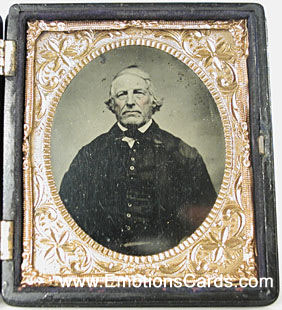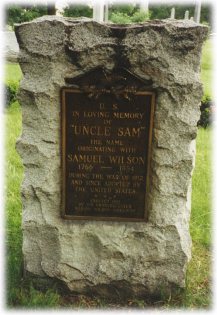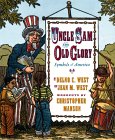
Turn Up Your Speakers
These Pages are High in Graphics
Please be patient as they load.
Uncle Sam
Who was Uncle Sam?
Historians aren't completely certain how the
character "Uncle Sam" was created, or who (if anyone) he was named
after. The prevailing theory is that Uncle Sam was named after Samuel Wilson.

Wilson was born in Arlington, Mass., on September
13, 1766. His childhood home was in Mason, New Hampshire. In 1789, he and his
brother Ebenezer walked to Troy, New York.
During the War of 1812, Wilson was in the business of slaughtering and packing meat. He provided large shipments of meat to the US Army, in barrels that were stamped with the initials "U.S." Supposedly, someone who saw the "U.S." stamp suggested -- perhaps as a joke -- that the initials stood for "Uncle Sam" Wilson. The suggestion that the meat shipments came from "Uncle Sam" led to the idea that Uncle Sam symbolized the federal government.
Samuel Wilson died in 1854. His grave is in the Oakwood Cemetery in Troy. (see below)
Uncle Sam's traditional appearance, with a white goatee and star-spangled suit, is an invention of artists and political cartoonists; Samuel Wilson did not look like the modern image of Uncle Sam. For example, Wilson was clean-shaven, while Uncle Sam is usually portrayed with a goatee.
Thomas Nast, a prominent 19th-century political cartoonist, produced many of the earliest cartoons of Uncle Sam. However, historians and collectors take note: Many of Nast's cartoons may appear to depict Uncle Sam, while in fact they depict Yankee Doodle or "Brother Jonathan." It is easy to mistake a Brother Jonathan cartoon for one of Uncle Sam, since both figures wear star-spangled suits of red, white and blue. As a rule, Brother Jonathan was drawn with a feather in his cap, while Uncle Sam was not; and Uncle Sam is nearly always drawn with a beard, while Brother Jonathan was clean-shaven.
Some have suggested that Dan Rice, a 19th-century clown, inspired Thomas Nast's Uncle Sam cartoons. Rice's clown costume consisted of a hat and star-spangled suit, much like the costome worn by Uncle Sam. However, Rice was born in 1823, and did not begin clowning until 1844; and Uncle Sam cartoons appeared as early as 1838. Therefore, it seems unlikely that Rice was, in fact, the inspiration for Nast's cartoons.
The single most famous portrait of Uncle Sam is
the "I WANT YOU" Army recruiting poster from World War I. The poster
was painted by James Montgomery Flagg in 1916-1917.
Samuel Wilson is buried in the Oakwood Cemetery, in the Northern part of Troy. Enter the cemetery from the Oakwood Ave. entrance, then follow the road to the right. You'll see signs that lead the way toward Sam Wilson's grave.
Samuel Wilson's headstone is very plain and small,
as is that of his wife Betsey Mann.
Both headstones lie flat on the ground.

Monument to "Uncle Sam"
In Association with Amazon

For More Patriotic Titles Click Here
Copyright ©Emotions Greeting Cards a division of VH Productions 2000-2002